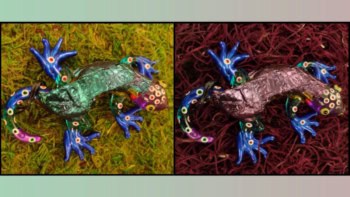
Physicists at Harvard University in the US have built a silicon waveguide that exhibits a refractive index of, or close to, zero when operating at near-infrared telecom wavelengths. The waveguide can transmit energy more efficiently than previous designs, offering potential applications in computing and communications.
Most materials have a refractive index of more than one, which means that they reduce both the speed and wavelength of light passing through them compared to light’s passage in a vacuum. But a material with zero refractive index instead boosts the speed and wavelength of light to infinity, leaving it with a temporal but no spatial variation. (The effect does not contradict special relativity because it regards a wave’s phase, which carries no information.)
Orad Reshef, who is now at the University of Ottawa, says he was inspired to investigate materials with zero refractive index because “zero was such an abstract concept”. But, more practically, he says that zero-index materials might boost nonlinearity in light that is a long-standing and as-yet unfulfilled requirement for optical computers. This would mean one photon being able to dictate the behaviour of another, so enabling optical transistors and other types of switches.
Because the refractive index of a material is defined as the square root of its relative permittivity and relative permeability multiplied together, a zero index can in principle be achieved by setting the permittivity to zero. This, in fact, has been done using metals at radio and far-infrared frequencies but Reshef points out that this was achieved with a finite permeability. As such, he says, impedance – defined as the square root of permeability over permittivity – “blows up”, meaning it becomes almost impossible to transfer electromagnetic radiation between the material and the outside world.
Pillars of gold
Two years ago, the Harvard group reported having overcome this problem using a metamaterial – a light-manipulating array of tiny artificial structures. The metamaterial in this case consisted of a network of 400 nm-diameter silicon pillars embedded in a polymer material and coated with films of gold. The gold, by acting as a mirror, was needed to make the pillars in effect infinitely tall, which should reduce the permeability of any passing light waves to zero.
The researchers demonstrated zero-index refraction by directing light at a prism-shaped formation of the silicon pillars and measuring the angle at which the light emerged from the far side of the prism. This result represented an important step towards practical chip-based applications, says Reshef, because unlike previous zero-index metamaterials light could propagate parallel to the silicon substrate. However, he points out that a prism itself is “an entirely useless structure”, since it cannot be built smaller than a certain size and because light spills out of it.
Infinite waves
In the latest work, the group fashioned the metamaterial into a waveguide – the photonic equivalent of an electrical wire. The waveguide consists of a single row of the metamaterial, but rather than pillars of silicon sitting in air it is instead made up of semicircular air holes within a strip of silicon. The greater concentration of silicon means there is now no need for gold coatings, which reduces costs and keeps the silicon purer.
Because the waveguide does not have any angled faces, the group had to come up with an alternative way of proving zero-index refraction. Ingeniously, it fed light into both ends of the device to set up a standing wave. Normally, the peaks and troughs of such a wave would be too close together to be visible, but the very low refractive index inside the waveguide meant that they were stretched far enough apart to be seen with an optical microscope.
Just how far apart depended strongly on the input wavelength. The researchers observed that at around 1625 nm the peaks and troughs of the standing wave became so stretched out that only one was visible at any one time. Given the finite size of the waveguide, they could not definitively say that they had observed a zero refractive index but they got down to as low as 0.03. “No one has seen an infinitely long-standing wave before,” says Reshef. “So as physicists we all thought that was breathtaking.”
Masaya Notomi of the NTT Basic Research Laboratories in Japan applauds Reshef and colleagues for having simultaneously demonstrated zero refractive index and low impedance in a “surprisingly simple” one-dimensional waveguide. But he adds that further research is needed for practical applications, given a substantial radiation loss from the waveguide.
The research is published in ACS Photonics.



